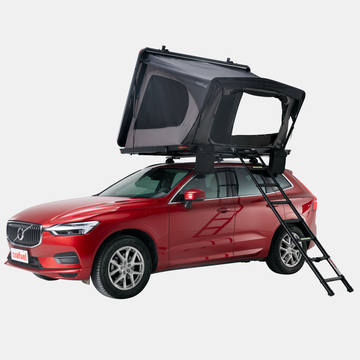
Rooftop tent style changes:
The style changes for rooftop tents (RTTs) have evolved over the years to meet the needs and preferences of campers, overlanders, and outdoor enthusiasts. These changes include design innovations, material advancements, and the introduction of various styles. Here are notable style changes in the evolution of rooftop tents:
Traditional Softshell RTTs: Early rooftop tents were often softshell designs with canvas or polyester walls. They typically featured a fold-out design, with an extendable ladder for access. Softshell tents were lightweight and easy to set up, catering to campers looking for simplicity and convenience.
Hardshell RTTs: In response to the growing popularity of rooftop tents, manufacturers introduced hardshell models.Hardshell RTTs feature a rigid, often aerodynamic, shell that encases the tent when closed. This design provides added protection to the tent fabric, improved aerodynamics, and a sleeker appearance.Hardshell tents are known for their quick setup times and robust construction.
Hybrid RTTs: Hybrid rooftop tents combine elements of both softshell and hardshell designs. These tents often have a hardshell cover for protection and durability, while the tent body is made of traditional canvas or polyester.
Hybrid designs aim to offer the best of both worlds, combining the durability of hardshells with the classic aesthetics of softshells.
Innovative Opening Mechanisms: The method of opening rooftop tents has evolved. Early designs involved manual unfolding, but many modern RTTs come with innovative opening mechanisms. Some feature gas-assisted struts for easy lifting, allowing users to set up the tent with minimal effort. Electric or remote-controlled opening systems have become available, adding an extra layer of convenience.
Annex Rooms and Add-Ons: Manufacturers have introduced annex rooms and add-ons to enhance the functionality of rooftop tents. Annex rooms are attached to the base of the tent, providing additional enclosed space for changing, storage, or dining. Add-ons such as awnings, skylights, and internal storage solutions contribute to a more versatile camping experience.
Integrated Features:
Rooftop tents today often come with integrated features to enhance comfort.
Built-in mattresses, adjustable ventilation, and insulation are common features in modern RTTs.
Some models may include USB ports, LED lighting, and power outlets for added convenience.
Customization and Personalization:
With the growth of the rooftop tent market, manufacturers offer a range of sizes, shapes, and designs to cater to diverse vehicle types and camper preferences.
Customization options, such as color choices and branding, allow users to personalize their rooftop tents.
Compact and Lightweight Designs:
As interest in overlanding and off-road adventures has increased, there's a trend toward more compact and lightweight rooftop tents.
These designs are well-suited for smaller vehicles and contribute to improved fuel efficiency.
The style changes in rooftop tents reflect the evolving needs and preferences of outdoor enthusiasts. Whether it's the sleek design of hardshell models, the versatility of hybrid designs, or the integration of high-tech features, rooftop tents continue to adapt to the demands of a diverse and growing camping community.
Design feature
From structure, roof top tent can be classified by many different shape and design. The most common type is as below:
1 straight on type: advantage is open easily, can be opened within 30 sec; disadvantage is not good appearance, also wearing out easily by fabric
2 triangles type: advantage is open easily, can be opened within 30 sec; also it is light weight normally; the price is cheap. Disadvantage is space is limited, it is only half space than rectangular type;
3 clam shape type: advantage is open easily, can be opened within 30 sec; also it have big enough space. Suitable for 2 adults normally.
4 Z shape type: advantage is good looking and have enough big space. Suitable for 2 adults normally. Disadvantage is a little bit heavy and the cost is a little bit expensive
5 hybrid type: advantage is good looking and also have enough big space, normally the width can be around 79inch. The size is even bigger than king room in the hotel, suitable for 2 adult and 2 kids, perfect for family travel.
From hard shell material, the hard shell normally is honeycomb alu shell or ABS shell. Honeycomb alu shell is very solid and durable, can by use around 5-7 years. It is characterized by high temperature resistance, corrosion resistance and anti-aging technology.
ABS is lighter and cheaper, but after use a few years, it may crack under long time outdoor use.
The soft shell roof top tent is light and cheap also, but not as solid as hard shell one, high wind resistance. Also set up time is longer. If you choose a quality roof top tent, soft shell is not ideal option.
As to fabric material, The two main types of fabrics used for rooftop tents are canvas and polyester. Some rooftop tents may also use a combination of both materials, such as a polyester rainfly combined with a canvas tent body.
normally high quality material is rip-stop Poly-oxford PU coated 3000mm with silver coating for fly and rip-stop polycotton PU 2000mm for inner. It have good effect for waterproof and UV proof.
Besides these, also need to consider weight capacity, ventilation, mattress confort, zippers and hardware, etc other factors.
Today we introduced the advantage and development history for rooftop tent, also the main feature when we choose roof top tent need consider.





